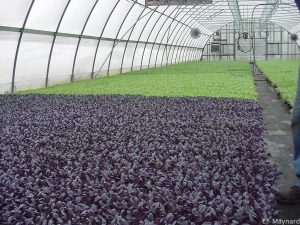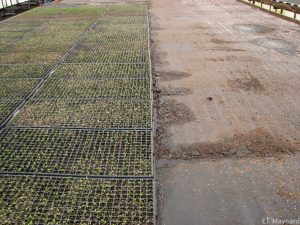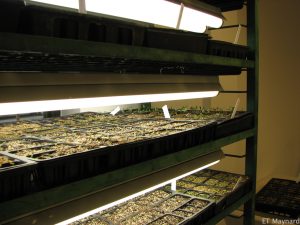Many Indiana vegetable crops begin life as transplants. If lack of nutrients, lack of light, disease, or other problems slow growth during this stage it may reduce establishment success and/or growth and yield in the field or high tunnel. Good management of the following factors should lead to healthy transplants (see Figure 1).
Time. Don’t seed transplants too early. Overgrown transplants are difficult to manage. If they get so root bound and shaded by other plants in the same flat that growth stops it will take them longer to resume growth in the field. They may become weakened and more susceptible to disease in the transplant tray and field. The ideal time depends on the crop and cell size, as well as the growing temperature. For ease of transplanting the finished transplant should have a well-developed root system that holds the root ball together, a sturdy stem, and be of a size that minimizes injury during the transplant process. Typical growing times are: cucumbers 2-3 weeks; squash and watermelon 3-4 weeks; cantaloupe 4-5 weeks; lettuce 4 weeks; cole crops, tomato, and pepper, 5-7 weeks; and onions 10-12 weeks.
Cell size. Vegetables are commonly grown in trays with cell diameters of 1/2 inch to 2 inches, and sometimes in pots up to 4 inches. Larger cells or pots usually lead to greater early yield in fruiting crops like tomatoes, peppers, and muskmelons. Larger cells are also easier to manage because the greater soil volume holds more water and nutrients. The ideal cell size for a particular operation will depend on space available for transplant production, crop harvest schedule, and management available for transplant production.
Growing media. Growing media should be free of plant diseases, have pH in desired range, and have enough pore space to allow good drainage and aeration. A laboratory test of the media for pH, electrical conductivity, and major nutrients is useful to avoid any unexpected problems, whether media is purchased or made on the farm. Many commercial labs have a test package specifically for greenhouse media. Take care when flats are filled to avoid packing media into cells because that will reduce the pore space.
Temperature. Maintaining temperature in the growing medium at the optimum for germination means seeds will germinate and emerge quickly, reducing the chance that pathogens will kill the germinating plant. A heat source under plug trays (see Figure 2) or a germination chamber that provides both humidity and optimal temperature can promote rapid and uniform germination. During production, air and growing medium temperature can be used to control speed of crop development, with faster development at higher temperatures up to the optimum for the crop. Avoid chilling temperatures (below 45-50°F) for warm-season crops. Be aware that cold irrigation water reduces the temperature of the growing media and may chill sensitive crops.
Light. Once seeds have emerged the brightness and duration of light directly influence how quickly the plants develop. Light provides energy to the plant to create the building blocks needed for the plant structure and biochemical machinery. With low light levels, seedlings will develop new leaves slowly, root development will be poor, stems will be thin, and plants will get tall and spindly, or ‘stretch.’ In a greenhouse natural light can be maximized by eliminating shade-producing objects in and outside the greenhouse, painting surfaces white to reflect light, minimizing condensation on the glazing, and orienting the roof or sidewall of the house perpendicular to the sun’s rays. In a growth room, artificial light sources that provide photosynthetically active light (wavelengths between 400 and 700 nanometers) may be used. A solid bank of cool white fluorescent lights provides an inexpensive light source for transplant production (see Figure 3). Lights should be placed as close to the seedlings as possible without injuring them to maximize the light they receive. Artificial light may also be used in a greenhouse but may not be a worthwhile investment for vegetable transplant production.
Water. An annual laboratory test of irrigation water is recommended to document alkalinity, electrical conductivity, pH, and mineral content. Well water characteristics can change from year to year, and this information is useful when troubleshooting a production problem or planning a fertilization program. A separate test for microbial quality is also needed for food safety purposes. Watering seedlings is a critical aspect of production. Watering too frequently reduces air available to plant roots and promotes a weak root system. Infrequent watering that leads to crop wilting will over-stress plants leading to long-term growth reduction. Also, when growing media gets too dry, fertilizer salts can become concentrated enough so that roots are injured and become more susceptible to diseases like pythium root rot. Transplant growth can be managed by judicious watering: keeping plants on the dry side will keep growth in check. Uneven distribution of water translates quickly into uneven growth of transplants. The person in charge of watering should understand the importance of the job, know how to determine when irrigation is needed, and use proper technique when hand watering to evenly supply water. If an automated system is used, check it for even distribution and plan for touch up watering in areas that dry out more quickly.
Mineral nutrition. The need for fertilization during transplant production depends largely on the nutrient content in the growing media and how long it takes to produce the transplant. In addition, judicious restriction of nutrients, particular nitrogen and phosphorus, can be used to manage transplant growth. The media soil test recommended above (item 3) will provide information about what nutrients are in the media. Most commercial peat-based or other soilless growing media designed for transplants contains a small amount of ‘starter fertilizer’ to supply nitrogen (N), phosphorus (P), and potassium (K). Seedlings grown for more than two or three weeks in this media will usually benefit from additional nutrients. Growing media that contains a significant amount of compost may have enough nutrients that no more fertilization is needed during production. A transplant production system should include a plan to supply mineral nutrients that takes into account nutrients supplied by the growing media and water. (A version of this article was previously published in Vegetable Crops Hotline 563.)


